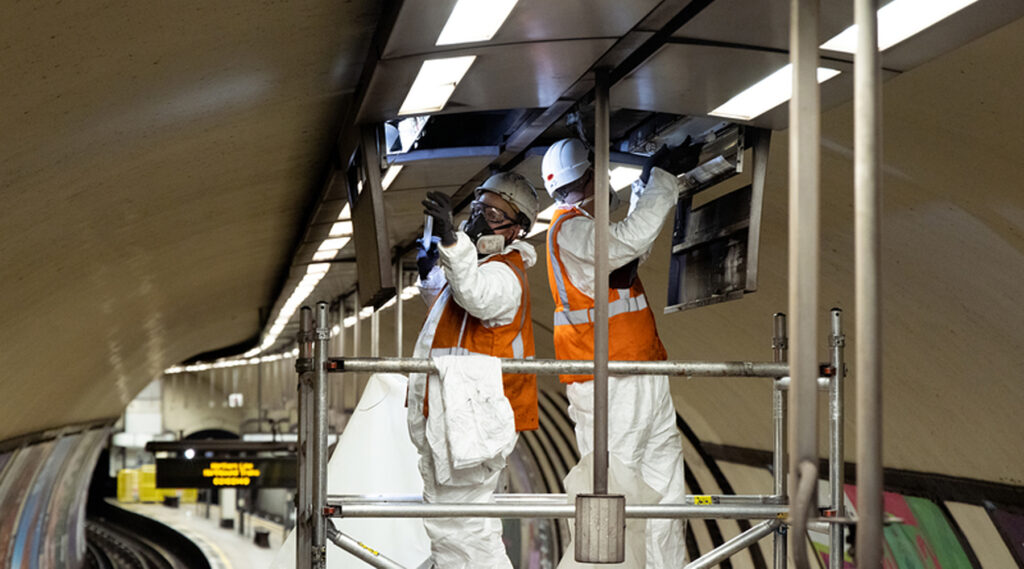An ongoing project to migrate London Underground’s station lights to lower-energy LEDs has seen around a third of the stations converted to the new lighting systems, brightening stations while lowering energy costs.
Oxford Circus is the latest to have been completed, and apart from having brighter, whiter lights, they also use about 60 percent less energy than the older lamps.
More than a third of Tube stations across London – such as Clapham North, Golders Green and Old Street- have been converted to LED lighting, with further stations, such as King’s Cross, Bank, Monument, and Westminster planned for conversion in the coming years.
Due to the scale and nature of the work, it can only be carried out when stations are closed and power is switched off, which on a 24/7 operational network means very few windows to carry out the work. It also is further complicated by the range of lighting assets in the stations, given that some are heritage stations that need special consideration.
As a result, TfL expects that it will take until 2032 to convert all their stations to LED lighting.
The lower energy bills tend to pay for the cost of replacing the lights over about two years, so the upfront capital costs translate into lower running costs after a couple of years. There are also more savings in future years as LED lamps last so much longer than the older lamps, so the ongoing maintenance cost of replacing lamps is slashed.
Although most of the benefit is cutting costs for TfL, the improved reliability of the lights should see the stations looking a bit better as fewer broken lights are around, which always looks unpleasant, as if maintenance is being missed.
The newer LEDs, aside from consuming less electricity and lasting longer, also put out about 10 percent more light, making the stations a bit brighter.
Transport for London (TfL) is also converted its bus shelters to use LEDs, with some 90% of the shelters now using LED lighting. The entire Elizabeth line is illuminated with LEDs, a decision that was taken back when LED lighting was still novel, and their suppliers often had to design fittings for the new format from scratch.
Glynn Barton, interim Chief Operating Officer at TfL, said: “Reducing carbon is a critical part of our work to reduce the impact of public transport on climate change. Upgrading stations to LED lighting not only provides a brighter, more welcoming environment for our customers, but it also helps us reduce maintenance costs, and helps make London a greener and more sustainable city for us all.”
As an aside, LED light strips also offer the potential to be more creative in how stations are illuminated, leading to the potential in the future to substantially enhance the appearance of heritage stations when opportunities arise.








If there’s a list I would say that Redbridge would be top of my list!
DLR are doing great work in the LED lights field too.
It’s beggars belief that this hasn’t happened already. Especially given the cost savings/LED lights having been the norm for so long
LED lights are still relatively new especially on railways where regulations permitting them only changed a few years ago.
For example, in domestic homes, the percentage of them using LEDs is still likely to be less than half (the most recent figure I can find is 14% from 2020), so it seems maybe a bit premature to complain about a railway taking time to migrate as well.
Given how many early LED Street lights failed quickly, with blown power supplies causing them to flash on and off, I’d be a little concerned about those Elizabeth Line lights lasting the distance. Mine you, you get what you pay for.. I’ve found cheap domestic lamps don’t last any longer than CFLs did, and I’ve just had an LED security light fail after a few months, whereas the old Halogen one had lasted at least 20 years.
Save even more money at Goodge St by painting it white rather than black at platform level. Yuk.
I went through Old Street station earlier and didn’t really notice any difference in the lighting on the Northern line platforms.
I also recall both Marble Arch and Kentish Town receiving LED lights over the last few years when I worked at those stations.
It was interesting raising a fault with the reporting centre that a “10 year guaranteed” LED tube on the escalator had failed at Marble Arch about 3 months after it had been installed!